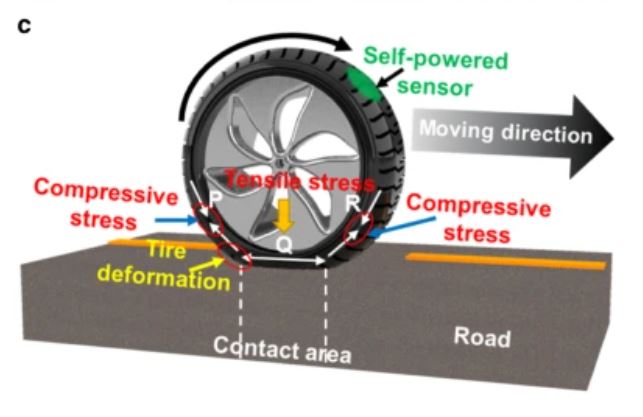Researchers at Virginia Tech have developed a breakthrough method to integrate self-powered, wireless strain sensors into smart tires using 3D printing and graphene. Their work was recently published in Nature, and describes the development and cost-effective integration of graphene-based piezoresistive sensors for tires which can measure and securely transmit tire data wirelessly. The sensors, which can provide information about tire loads, pressure, temperature and more, are energy-efficient and harvest strain energy from the tire itself to transfer wireless data.
The team behind this novel work included researchers from the Center for Tire Research (CenTiRe), and Department of Mechanical Engineering at VirginiaTech, as well as from the Department of Materials Science and Mechanical Engineering at Penn State.
Before there are fully autonomous cars, there will be smart tires. At least that’s what experts from Nokian Tyres (a Finnish tyre manufacturer known globally for specializing in winter tyres) believe as part of their prediction that smart tires will be commonplace within five years. Their view is that this would arise more out of the need to meet safety requirements, in a future where autonomous driving is more prevalent with regulations built around the safety and reliability of autonomous systems. Indeed, by estimates since 2015 through 2018, 10 million self-driving cars were expected to be on the road by 2020. While that’s nowhere near the case right now, advances and improvements indicate that such numbers would be a possibility in the near future.
Without a driver, tire condition and safety needs to be measured in new ways, using sensors and connected technologies that relay information directly to on-board or remote systems. These sensors will provide data to inform autonomous decision-making related to tire condition, temperature, pressure, grip and wear, and replacement. In the future, connected service models will see more automated preventive maintenance such as tire replacement services – where sensors notify on-board systems of the need for replacement, which in turn connect to nearby tire service providers who dispatch a new set of tires to the car owner. Even for current traditional cars, such sensor technology could be integrated with traditional tires, to reduce the number of road accidents caused due to tire-related issues.
Earlier in 2018, a collaboration between Virginia Tech and the Lawrence Livermore National Laboratory developed a novel stereolithography-based method to 3D print graphene in theoretically any size or shape, at a higher resolution than possible before. This enabled applications of graphene, which uniquely combines high thermal and electrical conductivity with strong mechanical properties, in aerospace, sensors, and batteries among other applications. Earlier this year, we had also reported on Virginia Tech’s development of a novel 3D printing method for latex rubber, at high resolution with mechanical properties akin to those of traditional latex rubber.
https://www.youtube.com/watch?v=8JltZDMEi0s
In this paper, the sensors are made by this novel 3D printing method using a graphene-based ink, which is designed with a wrinkled microstructure. The wrinkles provide high flexibility and prevent the sensor from being damaged or failing due to repeated or large deformations in the tire. Graphene sensors are found to deliver higher performance and are more sensitive compared to traditional sensors. With the 3D printing method developed by Virginia Tech researchers, the cost of a 3D printed strain sensor is as low as 2.7 cents. Their method uses an aerosol with silver nanoparticles to optimize the printing process, after which graphene oxide sheets are chemically reduced to obtain reduced graphene oxide with enhanced conductivity. These sensors can be directly printed on a variety of substrates, expanding its scope of applications to beyond just tire materials.
This isn’t the first time that efforts have been made to integrate wireless sensors into tires to make them ‘smart’ in sensing and communicating dynamic parameters in real-time. Yet the key difference in these efforts is that these sensors have relied on external power sources, are typically rigid, and their development and integration involves multiple steps, raising the complexity and cost of such wireless mechanisms for tires. For example, accelerometers can be rigid, capacitative sensors have varying sensitivity, energy harvesting approaches using electromagnetics can be large-sized and difficult to integrate, or nanogenerators which are flexible, but expensive to fabricate. Eventually, the piezoelectric patch was the chosen approach for researchers in this case, given its flexibility, ability to bear large deformations without failure, cost-effectiveness, and ease of integration.
Subscribe to Our Email Newsletter
Stay up-to-date on all the latest news from the 3D printing industry and receive information and offers from third party vendors.
Print Services
Upload your 3D Models and get them printed quickly and efficiently.
You May Also Like
Johns Hopkins University Researchers Develop HyFAM Technology
Two scientists from Johns Hopkins University, Nathan C. Brown and Jochen Mueller, have developed a hybrid manufacturing technology they call HyFam, or Hybrid Formative Additive Manufacturing. Their work on this technology...
3D Printing G-Code Gets an Upgrade: T-Code
Good old G-Code still manages many 3D printers, great and small. Just like the STL, it’s a standard that enables collaboration while also holding the additive manufacturing (AM) industry back....
AM Rewind: The Biggest News and Trends of 2024
After a sluggish 2023, driven by persistent inflation and geopolitical tensions, 2024 has seen some recovery. Economic growth climbed from about 2.8 percent in 2023 to a modest 3.2 percent...
Metal Wire 3D Printer OEM ValCUN Announces Plans for 2025 Expansion
ValCUN, a Belgian original equipment manufacturer (OEM) of wire-based metal additive manufacturing (AM) hardware, has announced that the company has entered the next phase of its growth trajectory, making key...




































